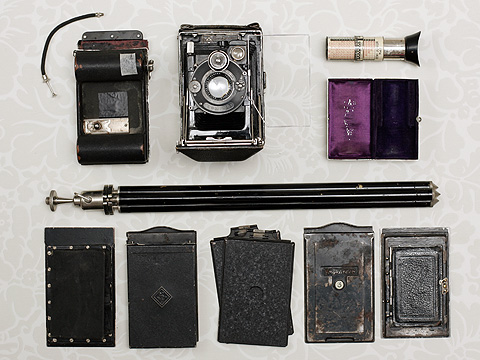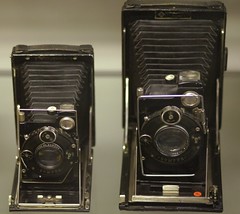Difference between revisions of "Patent Etui"
m (Added links) |
m (link) |
||
| Line 78: | Line 78: | ||
|image= http://farm6.static.flickr.com/5144/5574186708_2a6d53913b_z.jpg | |image= http://farm6.static.flickr.com/5144/5574186708_2a6d53913b_z.jpg | ||
|image_align= center | |image_align= center | ||
| − | |image_text= ''1935 Advert in | + | |image_text= ''1935 Advert in [[The British Journal Photographic Almanac]]'' |
|image_by= Ian Grant | |image_by= Ian Grant | ||
|image_rights= with permission | |image_rights= with permission | ||
Revision as of 12:53, 11 December 2013

|
| Patent Etui with Carl Zeiss Jena – Tessar (4.5/105mm) Accessories: rollfilm adapter, extinction meter, tripod, film sheet or plate holders. image by Siim Vahur (Image rights) |
The Patent Etui are extra-slim folding plate cameras, they were manufactured in two sizes 9×12cm and 6.5×9cm by KW Kamera Werkstätten Guthe & Thorsch of Dresden between 1920 and 1938. Although originally designed for glass plates both sizes also accept Rada or Rollex 120 6×9 roll film backs as well as film packs.
The 9×12 Patent Etui weighs 815g, and was considerably smaller than most of its German competitors. In comparison a 4×5in Crown Graphic weighs 2.4kg.
The 9×12 cameras were often fitted with an f/4.5 135mm Zeiss Tessar initially in a dial-set Compur, and after 1931 in the new rim-set Compur. They were also available with an f/4.5 150mm Tessar.
  
|
 
|
| Patent Etui Luxus, 6.5×9cm, Tessar 10.5cm f/4.5, dial-set Compur. Pictures by eBayer Yalluflex. (Image rights) |
The 6.5×9 cameras were usually fitted with an f/4.5 105mm Zeiss Tessar, again in a dial-set Compur, and later in the new rim-set Compur. They were also available with an f/4.5 120mm Tessar. Two budget triplet lenses the f/4.5 & f/6.3 105mm Meyer Görlitz Anastigmatic Trioplan were also available, the f/4.5 in a Compur shutter and the f/6.3 in a 3 speed Vario shutter.
  
|
| Patent Etui Luxus, 6.5×9cm, rim-set Compur. Pictures by eBayer Yalluflex. (Image rights) |
A few Patent Etui's were also sold with lenses from a variety of other manufacturers, and there were also some variations of the two basic models, including one with no focus rack adjustment instead having a Schneider Radionar with front cell focussing, and an Ibsor shutter. Not all cameras were fitted with the sports finder.
|
| ||||
| Patent Etui 9×12. Among the Patent Etui's attractions was its extreme compactness when folded. Images by Ian Grant. (Image rights) | |||||

|
| Patent Etui 9×12 (left) alongside an Orionwerks 9×12 camera. image by Ian Grant (Image rights) |

|
| two sizes image by Uwe Kulick (Image rights) |

|
| 1935 Advert in The British Journal Photographic Almanac image by Ian Grant (Image rights) |
A Japanese copy of the 6.5×9 model, called the Prince Peerless, was made from 1934.
Japanese advertisements

|

|
| Advertisement by Yamashita Yūjirō Shōten in Ars Camera November 1924, showing the Patent Etui (パテント・ヱツヰ・カメラ) and the Thowe plate folder (ソウヱカメラ). (Image rights) | Leaflet by Photo News, November 1938. (Image rights) |
Bibliography
- Ars Camera. Advertisement by Yamashita Yūjirō Shōten in November 1924. No page number.
- Photo News Sha. Leaflet presenting the Rolleicord, Perle, Semi Olympus II and Patent Etui, dated November 1938. Document reproduced in this Flickr set by Rebollo_fr.
- Instruction manual for a Patent-Etui 6.5 X 9 at www.orphancameras.com

